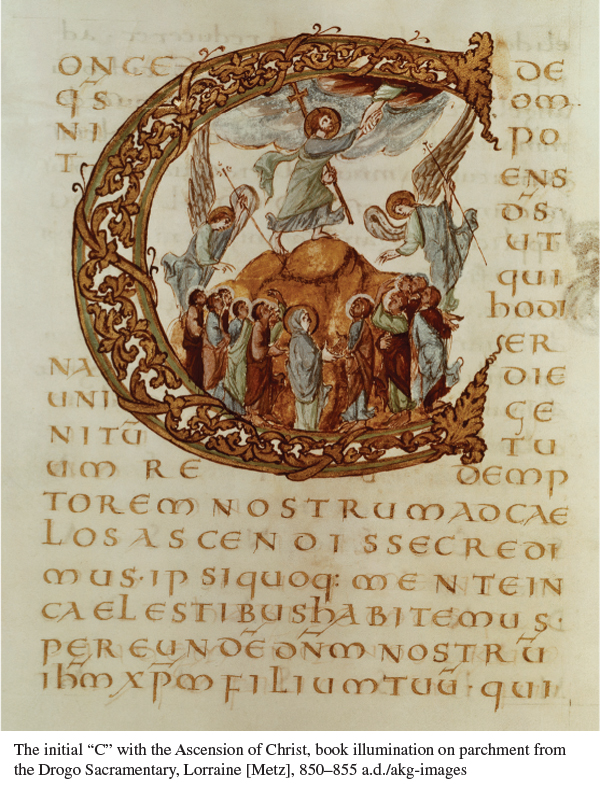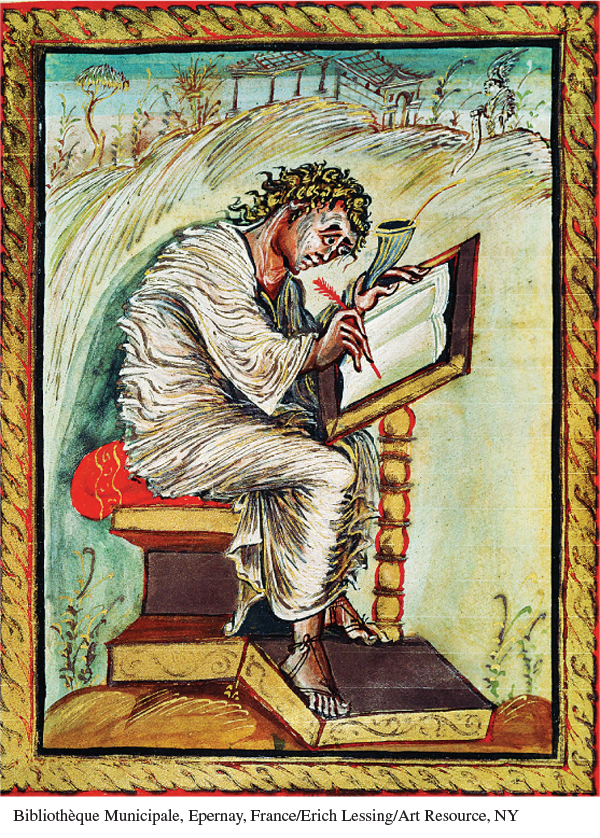A History of Western Society: Printed Page 234
A History of Western Society, Value Edition: Printed Page 222
A History of Western Society, Concise Edition: Printed Page 236
The Carolingian Renaissance
In Roman Gaul through the fifth century, the culture of members of the elite rested on an education that stressed grammar, Greco-

Charlemagne directed that every monastery in his kingdom should cultivate learning and educate the monks and secular clergy so that they would have a better understanding of the Christian writings. He also urged the establishment of cathedral and monastic schools where boys might learn to read and to pray properly. Thus the main purpose of this rebirth of learning was to promote an understanding of the Scriptures and of Christian writers and to instruct people to pray and praise God in the correct manner.
Women shared with men the work of evangelization and the new Christian learning. Rulers, noblemen, and noblewomen founded monasteries for nuns, each governed by an abbess. The abbess oversaw all aspects of life in the monastery. She handled the business affairs, supervised the copying of manuscripts, and directed the daily round of prayer and worship. Women’s monasteries housed women who were unmarried, and also often widows, children being taught to read and recite prayers and chants, elderly people seeking a safe place to live, and travelers needing hospitality. Some female houses were, in fact, double monasteries in which the abbess governed two adjoining establishments, one for women and one for men. Monks provided protection from attack and did the heavy work on the land in double monasteries, but nuns handled everything else.
In monasteries and cathedral schools, monks, nuns, and scribes copied books and manuscripts and built up libraries. They developed the beautifully clear handwriting known as “Carolingian minuscule,” with both uppercase and lowercase letters, from which modern Roman type is derived. In this era before printed books, works could survive only if they were copied. Almost all of the works of Roman authors that we are now able to read, both Christian and secular, were preserved by the efforts of Carolingian scribes. Some scholars went beyond copying to develop their own ideas, and by the middle years of the ninth century there was a great outpouring of more sophisticated original works. Ecclesiastical writers imbued with the legal ideas of ancient Rome and the theocratic ideals of Saint Augustine instructed the semibarbaric rulers of the West.
The most important scholar at Charlemagne’s court was Alcuin (al-
Through monastic and cathedral schools, basic literacy in Latin was established among some of the clergy and even among some of the nobility, a change from Merovingian times. By the tenth century the patterns of thought and the lifestyles of educated western Europeans were those of Rome and Latin Christianity. Most people, however, continued to live in an oral world. They spoke local languages, which did not have a written form. Christian services continued to be conducted in Latin, but not all village priests were able to attend a school, and many simply learned the service by rote. Some Latin words and phrases gradually penetrated the various vernacular languages, but the Carolingian Renaissance did not trickle down to ordinary people.

This division between a learned culture of Latin that built on the knowledge of the ancient world and a vernacular culture of local traditions can also be seen in medicine. Christian teaching supported concern for the poor, sick, and downtrodden. Churchmen taught that all knowledge came from God, who had supplied it for people to use for their own benefit. The foundation of a medical school at Salerno in southern Italy in the ninth century gave a tremendous impetus to medical study. The school’s location attracted Arab, Greek, and Jewish physicians from all over the Mediterranean region. Students flocked there even from northern Europe.
Despite the advances at Salerno, however, physicians were few in the early Middle Ages, and only the rich could afford them. Local folk medicine practiced by nonprofessionals provided help for commoners, with treatments made from herbs, bark, and other natural ingredients. Infants and children were especially susceptible to a range of illnesses, and about half of the children born died before age five. Although a few people lived into their seventies, most did not, and a forty-